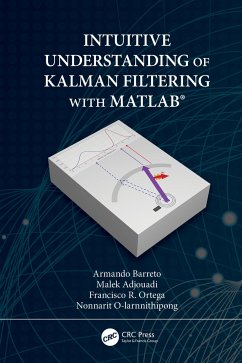Armando Barreto, Malek Adjouadi, Francisco Ortega
Intuitive Understanding of Kalman Filtering with MATLAB(R)
Armando Barreto, Malek Adjouadi, Francisco Ortega
Intuitive Understanding of Kalman Filtering with MATLAB(R)
- Gebundenes Buch
- Merkliste
- Auf die Merkliste
- Bewerten Bewerten
- Teilen
- Produkt teilen
- Produkterinnerung
- Produkterinnerung
The emergence of affordable micro sensors, such as MEMS Inertial Measurement Systems, which are being applied in embedded systems and Internet-of-Things devices, has brought techniques such as Kalman Filtering, capable of combining information from multiple sensors or sources, to the interest of students and hobbyists.
Andere Kunden interessierten sich auch für
![Narrative Design Narrative Design]() Michael BreaultNarrative Design174,99 €
Michael BreaultNarrative Design174,99 €![We Deserve Better Villains We Deserve Better Villains]() Jai KristjanWe Deserve Better Villains145,99 €
Jai KristjanWe Deserve Better Villains145,99 €![Dramatic Storytelling & Narrative Design Dramatic Storytelling & Narrative Design]() Ross BergerDramatic Storytelling & Narrative Design154,99 €
Ross BergerDramatic Storytelling & Narrative Design154,99 €![Understanding Kids, Play, and Interactive Design Understanding Kids, Play, and Interactive Design]() Mark SchlichtingUnderstanding Kids, Play, and Interactive Design145,99 €
Mark SchlichtingUnderstanding Kids, Play, and Interactive Design145,99 €![Love and Electronic Affection Love and Electronic Affection]() Lindsay GraceLove and Electronic Affection154,99 €
Lindsay GraceLove and Electronic Affection154,99 €![The Craft and Science of Game Design The Craft and Science of Game Design]() Philippe O'ConnorThe Craft and Science of Game Design106,99 €
Philippe O'ConnorThe Craft and Science of Game Design106,99 €![Cooperative Gaming Cooperative Gaming]() Alayna ColeCooperative Gaming145,99 €
Alayna ColeCooperative Gaming145,99 €-
-
-
The emergence of affordable micro sensors, such as MEMS Inertial Measurement Systems, which are being applied in embedded systems and Internet-of-Things devices, has brought techniques such as Kalman Filtering, capable of combining information from multiple sensors or sources, to the interest of students and hobbyists.
Produktdetails
- Produktdetails
- Verlag: Taylor & Francis Ltd (Sales)
- Seitenzahl: 230
- Erscheinungstermin: 7. September 2020
- Englisch
- Abmessung: 234mm x 156mm x 16mm
- Gewicht: 526g
- ISBN-13: 9780367191351
- ISBN-10: 0367191350
- Artikelnr.: 69937842
- Herstellerkennzeichnung
- Libri GmbH
- Europaallee 1
- 36244 Bad Hersfeld
- gpsr@libri.de
- Verlag: Taylor & Francis Ltd (Sales)
- Seitenzahl: 230
- Erscheinungstermin: 7. September 2020
- Englisch
- Abmessung: 234mm x 156mm x 16mm
- Gewicht: 526g
- ISBN-13: 9780367191351
- ISBN-10: 0367191350
- Artikelnr.: 69937842
- Herstellerkennzeichnung
- Libri GmbH
- Europaallee 1
- 36244 Bad Hersfeld
- gpsr@libri.de
Malek Adjouadi, PhD, is a Ware professor with the Department of Electrical and Computer Engineering at Florida International University, Miami. He received his PhD from the Electrical Engineering Department at the University of Florida, Gainesville. He is the founding director of the Center for Advanced Technology and Education funded by the National Science Foundation. His earlier work on computer vision to help persons with blindness led to his testimony to the US Senate on the committee of Veterans Affairs on the subject of technology to help persons with disabilities. His research interests are in imaging, signal processing and machine learning with applications in brain research and assistive technology. Armando Barreto, PhD, is a professor of the Electrical and Computer Engineering Department at Florida International University, Miami, as well as the director of FIU's Digital Signal Processing Laboratory, with more than 25 years of experience teaching DSP to undergraduate and graduate students. He earned his PhD in electrical engineering from the University of Florida, Gainesville. His work has focused on applying DSP techniques to the facilitation of human-computer interactions, particularly for the benefit of individuals with disabilities. He has developed human-computer interfaces based on the processing of signals and has developed a system that adds spatialized sounds to the icons in a computer interface to facilitate access by individuals with "low vision." With his research team, he has explored the use of Magnetic, Angular-Rate and Gravity (MARG) sensor modules and Inertial Measurement Units (IMUs) for human-computer interaction applications. He is a senior member of the Institute of Electrical and Electronics Engineers (IEEE) and the Association for Computing Machinery (ACM). Francisco R. Ortega, Ph.D. is an Assistant Professor at Colorado State University and Director of the natural user interaction lab (NUILAB). Dr. Ortega earned his Ph.D. in Computer Science (CS) in the field of Human-Computer Interaction (HCI) and 3D User Interfaces (3DUI) from Florida International University (FIU). He also held a position of Post-Doc and Visiting Assistant Professor at FIU between February 2015 to July 2018. Broadly speaking, his research has focused on gesture interaction, which includes gesture recognition and elicitation. His main research area focuses on improving user interaction by (a) eliciting (hand and full-body) gesture sets by user elicitation, and (b) developing interactive gesture-recognition algorithms. His secondary research aims to discover how to increase interest for CS in non-CS entry-level college students via virtual and augmented reality games. His research has resulted in multiple peer-reviewed publications in venues such as ACM ISS, ACM SUI, and IEEE 3DUI, among others. He is the first-author of Interaction Design for 3D User Interfaces: The World of Modern Input Devices for Research, Applications, and Game Development book by CRC Press. Nonnarit O-larnnithipong, Ph.D., is an Instructor at Florida International University. Dr. O-larnnithipong earned his Ph.D. in Electrical Engineering, majoring in Digital Signal Processing from Florida International University (FIU). He also held a position of Post-Doctoral Associate at FIU between January to April 2019. His research has focused on (a) implementing the sensor fusion algorithm to improve orientation measurement using MEMS inertial and magnetic sensors, and (b) developing a 3D hand motion tracking system using IMUs and infrared cameras. His research has resulted in multiple peer-reviewed publications in venues such as HCI-International and IEEE Sensors.
Part I Background Chapter 1
System Models and Random Variables 3 Chapter 2
Multiple Random Sequences Chapter 3
Conditional Probability, Bayes' Rule and Bayesian Estimation 45 Part II Where Does Kalman Filtering Apply and What Does It Intend to Do? Chapter 4
A Simple Scenario Where Kalman Chapter 5
General Scenario Addressed by Kalman Filtering and Specific Cases 61 Chapter 6
Arriving at the Kalman Filter Algorithm 75 Chapter 7
Reflecting on the Meaning and Evolution of the Entities in the Kalman Filter Algorithm 87 Part III Examples in MATLAB® Chapter 8
MATLAB® Function to Implement and Exemplify the Kalman Filter 103 Chapter 9
Univariate Example of Kalman Filter in MATLAB® 113 Chapter 10
Multivariate Example of Kalman Filter in MATLAB® 131 Part IV Kalman Filtering Application to IMUs Chapter 11
Kalman Filtering Applied to 2-Axis Attitude Estimation from Real IMU Signals 153 Chapter 12
Real-Time Kalman Filtering Application to Attitude Estimation from IMU Signals 179 APPENDIX A
LISTINGS OF THE FILES FOR REAL-TIME IMPLEMENTATION OF THE KALMAN FILTER FOR ATTITUDE ESTIMATION WITH ROTATIONS IN 2 AXES, 197
System Models and Random Variables 3 Chapter 2
Multiple Random Sequences Chapter 3
Conditional Probability, Bayes' Rule and Bayesian Estimation 45 Part II Where Does Kalman Filtering Apply and What Does It Intend to Do? Chapter 4
A Simple Scenario Where Kalman Chapter 5
General Scenario Addressed by Kalman Filtering and Specific Cases 61 Chapter 6
Arriving at the Kalman Filter Algorithm 75 Chapter 7
Reflecting on the Meaning and Evolution of the Entities in the Kalman Filter Algorithm 87 Part III Examples in MATLAB® Chapter 8
MATLAB® Function to Implement and Exemplify the Kalman Filter 103 Chapter 9
Univariate Example of Kalman Filter in MATLAB® 113 Chapter 10
Multivariate Example of Kalman Filter in MATLAB® 131 Part IV Kalman Filtering Application to IMUs Chapter 11
Kalman Filtering Applied to 2-Axis Attitude Estimation from Real IMU Signals 153 Chapter 12
Real-Time Kalman Filtering Application to Attitude Estimation from IMU Signals 179 APPENDIX A
LISTINGS OF THE FILES FOR REAL-TIME IMPLEMENTATION OF THE KALMAN FILTER FOR ATTITUDE ESTIMATION WITH ROTATIONS IN 2 AXES, 197
Part I Background
Chapter 1 - System Models and Random Variables 3
Chapter 2 - Multiple Random Sequences
Chapter 3 - Conditional Probability, Bayes' Rule and Bayesian Estimation 45
Part II Where Does Kalman Filtering Apply and What Does It Intend to Do?
Chapter 4 - A Simple Scenario Where Kalman
Chapter 5 - General Scenario Addressed by Kalman Filtering and Specific Cases 61
Chapter 6 - Arriving at the Kalman Filter Algorithm 75
Chapter 7 - Reflecting on the Meaning and Evolution of the Entities in the Kalman Filter Algorithm 87
Part III Examples in MATLAB®
Chapter 8 - MATLAB® Function to Implement and Exemplify the Kalman Filter 103
Chapter 9 - Univariate Example of Kalman Filter in MATLAB® 113
Chapter 10 - Multivariate Example of Kalman Filter in MATLAB® 131
Part IV Kalman Filtering Application to IMUs
Chapter 11 - Kalman Filtering Applied to 2-Axis Attitude Estimation from Real IMU Signals 153
Chapter 12 - Real-Time Kalman Filtering Application to Attitude Estimation from IMU Signals 179
APPENDIX A LISTINGS OF THE FILES FOR REAL-TIME IMPLEMENTATION OF THE KALMAN
FILTER FOR ATTITUDE ESTIMATION WITH ROTATIONS IN 2 AXES, 197
Chapter 1 - System Models and Random Variables 3
Chapter 2 - Multiple Random Sequences
Chapter 3 - Conditional Probability, Bayes' Rule and Bayesian Estimation 45
Part II Where Does Kalman Filtering Apply and What Does It Intend to Do?
Chapter 4 - A Simple Scenario Where Kalman
Chapter 5 - General Scenario Addressed by Kalman Filtering and Specific Cases 61
Chapter 6 - Arriving at the Kalman Filter Algorithm 75
Chapter 7 - Reflecting on the Meaning and Evolution of the Entities in the Kalman Filter Algorithm 87
Part III Examples in MATLAB®
Chapter 8 - MATLAB® Function to Implement and Exemplify the Kalman Filter 103
Chapter 9 - Univariate Example of Kalman Filter in MATLAB® 113
Chapter 10 - Multivariate Example of Kalman Filter in MATLAB® 131
Part IV Kalman Filtering Application to IMUs
Chapter 11 - Kalman Filtering Applied to 2-Axis Attitude Estimation from Real IMU Signals 153
Chapter 12 - Real-Time Kalman Filtering Application to Attitude Estimation from IMU Signals 179
APPENDIX A LISTINGS OF THE FILES FOR REAL-TIME IMPLEMENTATION OF THE KALMAN
FILTER FOR ATTITUDE ESTIMATION WITH ROTATIONS IN 2 AXES, 197
Part I Background Chapter 1
System Models and Random Variables 3 Chapter 2
Multiple Random Sequences Chapter 3
Conditional Probability, Bayes' Rule and Bayesian Estimation 45 Part II Where Does Kalman Filtering Apply and What Does It Intend to Do? Chapter 4
A Simple Scenario Where Kalman Chapter 5
General Scenario Addressed by Kalman Filtering and Specific Cases 61 Chapter 6
Arriving at the Kalman Filter Algorithm 75 Chapter 7
Reflecting on the Meaning and Evolution of the Entities in the Kalman Filter Algorithm 87 Part III Examples in MATLAB® Chapter 8
MATLAB® Function to Implement and Exemplify the Kalman Filter 103 Chapter 9
Univariate Example of Kalman Filter in MATLAB® 113 Chapter 10
Multivariate Example of Kalman Filter in MATLAB® 131 Part IV Kalman Filtering Application to IMUs Chapter 11
Kalman Filtering Applied to 2-Axis Attitude Estimation from Real IMU Signals 153 Chapter 12
Real-Time Kalman Filtering Application to Attitude Estimation from IMU Signals 179 APPENDIX A
LISTINGS OF THE FILES FOR REAL-TIME IMPLEMENTATION OF THE KALMAN FILTER FOR ATTITUDE ESTIMATION WITH ROTATIONS IN 2 AXES, 197
System Models and Random Variables 3 Chapter 2
Multiple Random Sequences Chapter 3
Conditional Probability, Bayes' Rule and Bayesian Estimation 45 Part II Where Does Kalman Filtering Apply and What Does It Intend to Do? Chapter 4
A Simple Scenario Where Kalman Chapter 5
General Scenario Addressed by Kalman Filtering and Specific Cases 61 Chapter 6
Arriving at the Kalman Filter Algorithm 75 Chapter 7
Reflecting on the Meaning and Evolution of the Entities in the Kalman Filter Algorithm 87 Part III Examples in MATLAB® Chapter 8
MATLAB® Function to Implement and Exemplify the Kalman Filter 103 Chapter 9
Univariate Example of Kalman Filter in MATLAB® 113 Chapter 10
Multivariate Example of Kalman Filter in MATLAB® 131 Part IV Kalman Filtering Application to IMUs Chapter 11
Kalman Filtering Applied to 2-Axis Attitude Estimation from Real IMU Signals 153 Chapter 12
Real-Time Kalman Filtering Application to Attitude Estimation from IMU Signals 179 APPENDIX A
LISTINGS OF THE FILES FOR REAL-TIME IMPLEMENTATION OF THE KALMAN FILTER FOR ATTITUDE ESTIMATION WITH ROTATIONS IN 2 AXES, 197
Part I Background
Chapter 1 - System Models and Random Variables 3
Chapter 2 - Multiple Random Sequences
Chapter 3 - Conditional Probability, Bayes' Rule and Bayesian Estimation 45
Part II Where Does Kalman Filtering Apply and What Does It Intend to Do?
Chapter 4 - A Simple Scenario Where Kalman
Chapter 5 - General Scenario Addressed by Kalman Filtering and Specific Cases 61
Chapter 6 - Arriving at the Kalman Filter Algorithm 75
Chapter 7 - Reflecting on the Meaning and Evolution of the Entities in the Kalman Filter Algorithm 87
Part III Examples in MATLAB®
Chapter 8 - MATLAB® Function to Implement and Exemplify the Kalman Filter 103
Chapter 9 - Univariate Example of Kalman Filter in MATLAB® 113
Chapter 10 - Multivariate Example of Kalman Filter in MATLAB® 131
Part IV Kalman Filtering Application to IMUs
Chapter 11 - Kalman Filtering Applied to 2-Axis Attitude Estimation from Real IMU Signals 153
Chapter 12 - Real-Time Kalman Filtering Application to Attitude Estimation from IMU Signals 179
APPENDIX A LISTINGS OF THE FILES FOR REAL-TIME IMPLEMENTATION OF THE KALMAN
FILTER FOR ATTITUDE ESTIMATION WITH ROTATIONS IN 2 AXES, 197
Chapter 1 - System Models and Random Variables 3
Chapter 2 - Multiple Random Sequences
Chapter 3 - Conditional Probability, Bayes' Rule and Bayesian Estimation 45
Part II Where Does Kalman Filtering Apply and What Does It Intend to Do?
Chapter 4 - A Simple Scenario Where Kalman
Chapter 5 - General Scenario Addressed by Kalman Filtering and Specific Cases 61
Chapter 6 - Arriving at the Kalman Filter Algorithm 75
Chapter 7 - Reflecting on the Meaning and Evolution of the Entities in the Kalman Filter Algorithm 87
Part III Examples in MATLAB®
Chapter 8 - MATLAB® Function to Implement and Exemplify the Kalman Filter 103
Chapter 9 - Univariate Example of Kalman Filter in MATLAB® 113
Chapter 10 - Multivariate Example of Kalman Filter in MATLAB® 131
Part IV Kalman Filtering Application to IMUs
Chapter 11 - Kalman Filtering Applied to 2-Axis Attitude Estimation from Real IMU Signals 153
Chapter 12 - Real-Time Kalman Filtering Application to Attitude Estimation from IMU Signals 179
APPENDIX A LISTINGS OF THE FILES FOR REAL-TIME IMPLEMENTATION OF THE KALMAN
FILTER FOR ATTITUDE ESTIMATION WITH ROTATIONS IN 2 AXES, 197









